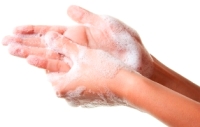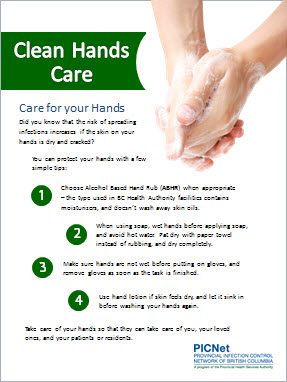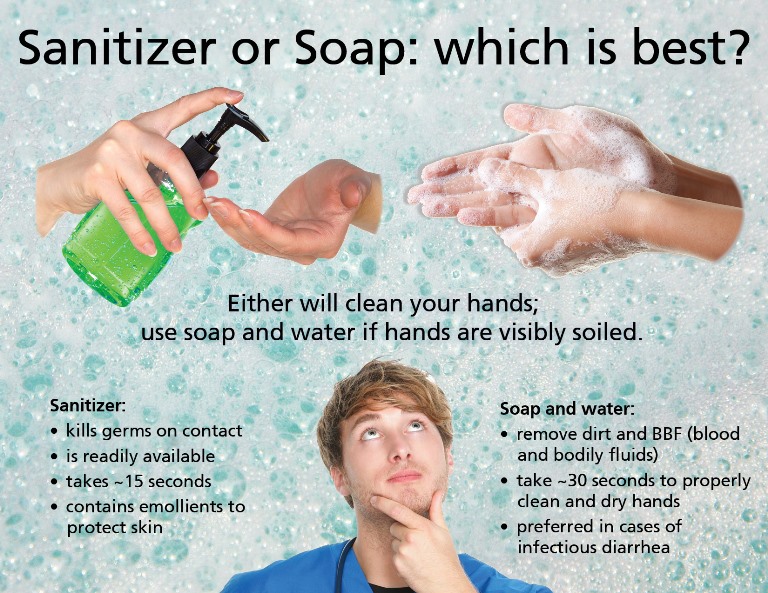Guidelines
Click to expand/close Provincial Best Practices for Hand Hygiene Guidelines Notice: The Provincial Best Practices for Hand Hygiene Guidelines are currently being updated. We will notify our community of practice and partners once the resource is revised and approved for publication. Provincial Best Practices for Hand Hygiene Guidelines: Facilities and Infrastructure Checklist Just Clean Your Hands (JCYH) Program, How to Protect Your Skin, and Four Moments of Hand Hygiene Hand Hygiene Practices in health-care settings Hand Hygiene Guidelines Click to expand/close The PHHWG is composed of representatives from each of the health authorities, the Ministry of Health, and the Provincial Infection Control Network of BC (PICNet). The group has been tasked with developing a mandatory province-wide hand hygiene program for the health authorities and assisting in its implementation for the individual health authorities. Download the two-page backgrounder. Click to expand/close Hand hygiene refers to removing or killing microorganisms on the hands and is one of the most effective measures to prevent the spread of infections. There are serious health implications and financial costs associated with healthcare associated infections (HAIs), which makes hand hygiene a priority. Either alcohol based hand rub (ABHR, also known as hand sanitizer) or soap and warm water are accepted methods of hand hygiene: Patients, volunteers, and visitors should be reminded of the importance of hand hygiene, especially before eating or preparing food, after using the toilet or other personal hygiene activities, before leaving their homes for public areas, and when returning home from public places. Two important components of hand hygiene are glove use and hand care: Did you know that the risk of spreading infections increases if the skin on your hands is dry and cracked? Healthy skin is your best defence against infection. If you think you have dermatitis or are experiencing hand/skin irritation: Gloves should be worn for: Many of PICNet’s infection control resources include hand hygiene: You can find all of PICNet’s available resources via the Resources menu.BC Guidelines and Resources
Published by the BC Ministry of Health, July 2012
(The document has “Appendix 1” at the top as it was originally issued as an Appendix to a Ministry Communiqué)
Published by the BC Ministry of Health, November 2013
(The document has “Appendix 5” at the top as it was originally issued as an Appendix to a Ministry Communiqué)Guidelines and Resources from Other Jurisdictions
Created By: Public Health Ontario
December 2023
Created By: Public Health Agency of Canada (PHAC)
March 2012
Created By: World Health Organization (WHO)
January 2009Provincial Hand Hygiene Program
 There is increasing awareness of the importance of hand hygiene (HH), not only to protect patients but to protect the health of health-care workers (HCW). In response to an Office of the Auditor General review on hand hygiene programs in healthcare, the Provincial Hand Hygiene Working Group (PHHWG) was formed with the support of the Ministry of Health Services and the BC Health Operations Council.
There is increasing awareness of the importance of hand hygiene (HH), not only to protect patients but to protect the health of health-care workers (HCW). In response to an Office of the Auditor General review on hand hygiene programs in healthcare, the Provincial Hand Hygiene Working Group (PHHWG) was formed with the support of the Ministry of Health Services and the BC Health Operations Council.The Working Group
Aim
Hand Cleaning Compliance (Auditing) Reports
More Hand Hygiene Resources
 Hand hygiene is the single most effective way of preventing the transmission of infections. Because microorganisms can be spread by anyone, hand hygiene is everybody’s responsibility: staff, patients, residents, visitors, and volunteers.
Hand hygiene is the single most effective way of preventing the transmission of infections. Because microorganisms can be spread by anyone, hand hygiene is everybody’s responsibility: staff, patients, residents, visitors, and volunteers.
Hand care
Your hands take care of others; do you take care of your hands?
You can protect your hands with a few simple tips:

You can download this information as a poster. (PDF file, 8×5 x 11)
![]()
Choose Alcohol Based Hand Rub (ABHR) unless otherwise instructed by Infection Prevention and Control: the ABHR used in all BC Health Authority facilities contains moisturizers, and doesn’t wash away skin oils.
![]()
When using soap, wet hands before applying soap, and avoid extremely hot or cold water (use warm). Pat dry with paper towel instead of rubbing, and dry completely. (Rubbing rather than patting, and not drying hands completely, are two of the main causes of skin irritation.)
![]()
Make sure hands are not wet before putting on gloves, and remove gloves as soon as the task is finished. (And don’t forget you need to clean hands again after glove use!)
![]()
Use hand lotion if skin feels dry, and let it sink in before washing your hands again.
Take care of your hands so that they can take care of you, your loved ones, and your patients.
Correct glove use: An important part of hand hygiene
When to use gloves
Hand cleaning
If gloves don’t protect against all germs, why do we use them?
Donning and Doffing
More important points:


